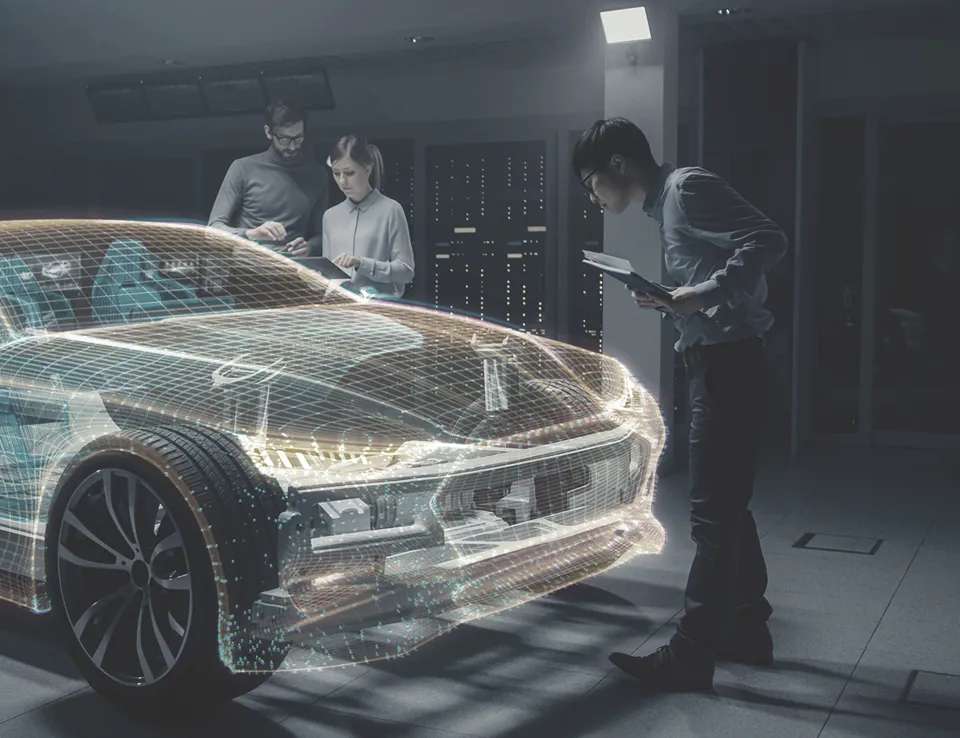What can mobility OEMs learn from other industries to solve their business transformation challenges?
Businesses involved in the creation of ICE powered vehicles have undergone significant change over the last few years as they plan and strategise for a more tech-enabled future of mobility. Significant challenges exist for those operators that are ‘behind the curve’ but disruption has the potential to lead to more opportunities to collaborate. Business leaders in the mobility industry can learn from other sectors that have already undergone significant transformation and apply this knowledge to their own strategies.
The advent of software defined vehicles
OEMs working with traditional ICE components have built up a track record of design and engineering expertise over the last 100 years. Yet with this success comes a presumption that knowledge and expertise is easily transferred to the electrification space, enabling seamless integration to a new breed of vehicles. However, for most, it’s simply not the case unless significant investment is made in people and processes.
Over the last five years, many of our clients in the Tier 1 space have been dealing with the first stage of migration from combustion engine-based product lines to a new generation of electrified and connected vehicles. This has required them to develop more technologically complex products combining mechanical, electronic and software elements.

The challenges facing ICE OEMs implementing software elements into their products
It is becoming increasingly necessary for OEMs to differentiate the software elements of their products. Software development for technologically advanced vehicle components creates acute engineering challenges. Historically, many of these businesses have had little experience with the level of software development complexity now required. Therefore, businesses require the right leadership to be in place to manage this transition.
The skill set involved in electrification within the mobility sector is vastly different to the one required for ICE. Although, that’s not to say the two cannot exist together, or that team members cannot adapt and become experts in electrification.
The reason why a process that has always worked for but now does not may well be down to the process involved. Businesses must now ensure they have the right skill set to solve new problems that are software related rather than predominantly mechanical or electronic.
Most of the components of an ICE vehicle have undergone a steady stream of R&D over the last 70 years to increase efficiency, power density and adapt to legislative changes during this time. However, as software and electronic technology becomes more of a driver for powertrain capabilities, not only does it become more of a challenge for operators, but it’s also more difficult for businesses to offer a unique consumer experience.
Ultimately, all deliverables, whether as part of an ICE variant, hybrid, or full electric powertrain, need to have seamless integration – if they coexist singularly, they won’t work well, if at all.
OEMs need to differentiate their product to remain competitive
Migration to alternative fuels, electrification and hybrid vehicles is happening at pace, but as there is little to differentiate one battery from another. Businesses need to look at other areas in which they can increase the value of their project and make it more attractive to the consumer.
Engines aren’t going to disappear in the next 20-30 years. There are lots of places in the world that are still heavily reliant on petrol or diesel vehicles, and where it is more problematic to develop an electrified offering. There is also little or no infrastructure in place to support different future fuel types in some areas of the world where there will continue to be a reliance on ICEs. However, for geographies where electrification is a possibility, software will ultimately become the key differentiator just as it has been in the electronics and consumer world.
There’s also a big question mark around future vehicle ownership. It’s likely that people living in urban environments will move towards Mobility as a Service, rather than owning their own car. It’s about finding the balance at which car ownership can co-exist with multi-model forms of transport and consumer preference.
What can the mobility market learn from other industries?
We have talked a lot previously about how a skill set within any business environment needs to adapt to meet existing and future requirements. This is particularly true within the automotive and industrial sectors, especially as the change curve is building momentum.
For some, advanced degrees can offer a bridge to learn new skills and to top up traditional skills. Learnings can be taken from industries that have already been through this process. The businesses operating in the communications industry, for example, regularly report on their current skill set as part of their standard knowledge base. It forms part of their strategic thinking and their future planning.
From a technology perspective, the communication industry is around 20 years ahead of most businesses operating in the automotive and industrial sectors. Cross-pollination can work and has recently been used sporadically for the automotive and industrial sectors. However, these businesses need to leverage the talent pool in the technology and semiconductor world who are further along the technology curve.
Drawing similarities between where the communications industry was 20 years ago, businesses operating in the automotive industry should be able to reduce their learning curve significantly.

OEMs need to assess their internal processes as product complexity increases
Businesses in the automotive sector are having to simultaneously manage delivering multi-function, multi-regional and multi product programmes with significant software content as we pivot towards electrification, connectivity, and shared mobility.
Some of our clients have been surprised that they have not been able to execute effectively on these new types of projects with a high degree complexity, despite their successful track record in developing older technologies and products.
Investment is required to meet technology and product aspirations. It is also critical that businesses take a realistic view on how working habits and business processes need to change to support an increase in technology complexity. And whilst it’s reasonable to assume that product lifecycles will need to accelerate – agile software development skills will need to be a key core capability.
Historical models with less formal project management structures for smaller teams could present a hurdle to businesses with the new requirement to coordinate teams up to 10 times larger. A more diligent project management structure is imperative to coordinate the growing cross-functional teams and their associated deliverables required to enable these kinds of programmes. Critical path needs to become the mantra and guiding principal for these teams.
Businesses in the mobility market have an opportunity to learn from industries that are ahead on the technology migration curve – yet to date there are limited signs these connections are being made. It is very rare for businesses to come across a fundamentally new problem that has not been faced by another organisation. However, only a small subset of organisations will look outside of their own sector for guidance. The businesses that do look outside often find solutions then enable them to excel at a fast pace and outsmart the competition. Andy Grove captured this notion well in his book, “Only the Paranoid Survive”.
A blog by Rimoon Agaiby, Head of Strategic Consulting, Germany









